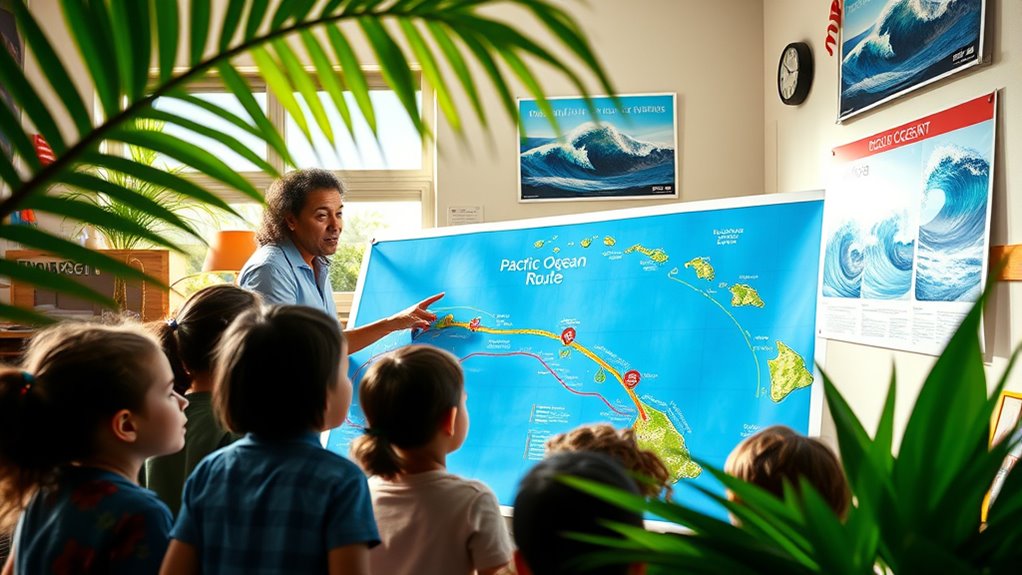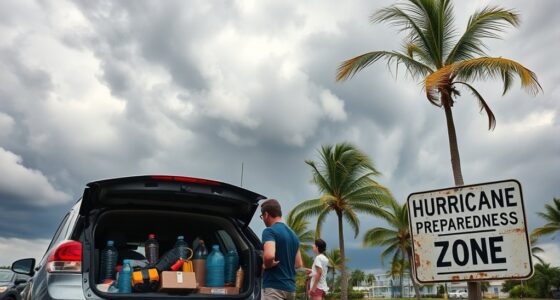Hawaii’s boosting tsunami education in coastal schools to give students essential skills for disaster preparedness. Programs focus on early warning systems, risk assessment, and community drills, ensuring you’re equipped to act during an emergency. You’ll learn the importance of understanding local geography and how it affects tsunami impacts. By participating in hands-on activities and awareness campaigns, students become active members of their communities, fostering resilience against future tsunami threats. Discover how these initiatives make a difference.
Key Takeaways
- Hawaii enhances tsunami education in coastal schools through tailored training programs focused on awareness and emergency response.
- Tsunami drills and awareness campaigns educate students on immediate actions during tsunami warnings, fostering community resilience.
- The Tsunami Science and Preparedness Certificate Program equips educators with knowledge on hazard assessment and local geography’s impact on tsunami risks.
- Collaborations with institutions like the University of Washington and NOAA enrich tsunami education content in coastal schools.
- Understanding local geography is emphasized to develop effective preparedness strategies and risk assessments for coastal communities.

When it comes to understanding and preparing for tsunamis, education plays an essential role in Hawaii. The state has implemented robust training programs aimed at enhancing awareness and readiness. One key initiative is the ITIC Training Program, which includes the Hawaii-based component known as ITP-Hawaii. This program leverages the state as a model for tsunami warning and response systems, allowing practitioners to share real-life experiences in small class sizes. Through this focused training, you’ll gain insights into effective strategies for mitigating tsunami risks.
The importance of timely warnings can’t be overstated, and the Pacific Tsunami Warning Center is central to Hawaii’s early warning systems. These centers analyze data from earthquakes, tide gauges, and buoys to predict tsunami arrival times. When potential tsunami-inducing earthquakes occur, they issue tsunami watches, which are essential for emergency officials to save lives and minimize coastal damage. Your understanding of these systems will empower you to act quickly during an emergency, giving you the tools to respond effectively.
In addition to training programs, the Certificate Program in Tsunami Science and Preparedness offers courses on hazard assessment and warning systems. Collaborations between institutions like the University of Washington and NOAA guarantee that educational content is thorough. You’ll engage in lectures, case studies, and even field trips to areas affected by past tsunamis, making the learning experience practical and relevant. This holistic understanding of tsunami resilience equips you to contribute positively to community preparedness efforts.
Coastal vulnerability is another significant aspect of tsunami education. While the main UH Mānoa Campus is low-risk, some coastal facilities face substantial threats. Understanding how the shape of the seafloor and coastal geography can amplify wave heights is important. You’ll learn that even a single tsunami event can lead to varying destruction across communities, which emphasizes the need for tailored preparedness.
International collaboration also enhances tsunami education, with ITIC offering international training sessions to engage local stakeholders. By studying successful cases from countries like Chile, you can appreciate the global nature of tsunami preparedness.
Finally, community preparedness is essential, especially for residents in low-lying areas. Tsunami drills and awareness campaigns help you and your neighbors stay vigilant. Public safety messages stress the importance of immediate action during warnings, guaranteeing that everyone knows what to do when a tsunami threatens. Through education, Hawaii is building a more resilient future against the unpredictable nature of tsunamis.
Frequently Asked Questions
What Are the Signs of an Impending Tsunami?
When you’re near the coast, watch for signs of an impending tsunami. If the ocean suddenly withdraws, exposing the sea floor, that’s a major warning.
Listen for a loud roaring sound, like a train. Look for unusual ocean behavior, such as sudden rises in water level or debris floating in the water.
If you notice any of these signs, you should move to higher ground immediately. Stay alert and be prepared.
How Can Parents Support Tsunami Education at Home?
Imagine a sunny day when your child suddenly asks about tsunamis. You can support their curiosity by integrating tsunami topics into everyday conversations.
Use resources like Google Earth for visual lessons, and create fun DIY tsunami simulations at home. Set up an emergency plan together, and participate in local drills.
Engaging in these activities not only prepares your family but also fosters a deeper understanding of tsunami safety and science.
Are There Any Tsunami Drills for Students?
Yes, there are tsunami drills for students, especially in coastal areas at risk.
These drills help you and your classmates learn evacuation procedures and emergency protocols. Schools often conduct them regularly, using warning sirens to simulate real-life scenarios.
Participating in these drills is essential for understanding how to stay safe during a tsunami. By practicing together, you’ll know the best routes and safe zones when an actual emergency occurs.
What Resources Are Available for Teachers on Tsunami Safety?
In your quest for tsunami safety resources, you’re in luck! Numerous educational tools are at your fingertips, including thorough teacher guides that offer structured lesson plans and FAQs on tsunamis.
You’ll find multimedia support like teaching charts and slideshow presentations that enhance learning. Additionally, inquiry-based activities engage students in hands-on experiences, making complex concepts more accessible.
Don’t forget to utilize local and global initiatives for even more resources tailored to your needs!
How Does Climate Change Affect Tsunami Risk in Hawaii?
Climate change greatly affects tsunami risk in Hawaii. Rising sea levels allow tsunamis to travel further inland, increasing the potential for coastal flooding.
As coastal erosion worsens and coral reefs decline due to warming oceans, natural barriers diminish, intensifying tsunami impacts. Increased ocean temperatures may also influence tectonic activity, leading to more geological disturbances.
You need to stay informed about these changes and support community efforts to enhance preparedness against future tsunami risks.
Conclusion
As Hawaii rides the wave of tsunami education, you’re not just learning; you’re building a lifeline to safety. Each lesson acts like a lighthouse, guiding you through the stormy seas of uncertainty. By arming yourself with knowledge, you’re not only protecting your own shores but also enriching your community’s resilience. So, embrace this opportunity—let the tide of awareness lift you, ensuring that when the waves come, you’re ready to stand tall and safe.










